- Abstract
- Harvest yield of Shishito peppers among winter and spring peppers (main data).
- Harvest volume of shishito peppers, one of the winter/spring peppers (by prefecture).
- Planted area of shishito peppers among winter and spring peppers (main data).
- The area planted with shishito peppers, a winter/spring pepper variety, by prefecture.
- Shipment volume of Shishito peppers among winter and spring peppers.
- Reference
Abstract
Based on data from 2022, the national winter/spring pepper harvest volume was 1.78kt, with a maximum cultivation area of 30ha and the highest shipping volume in Kochi at 1.35kt, for Shishito peppers, a fruit vegetable crop in Japanese agriculture. Based on these figures, it is likely that shishito peppers are produced on a relatively limited area and that efficient cultivation techniques are being used. In addition, Kochi had the highest shipping volume, suggesting that cultivation and demand for shishito peppers vary by region. This trend suggests that shishito peppers are cultivated extensively in certain regions and are produced to meet demand. Going forward, efforts will be needed to stabilize and expand shishito pepper production while maintaining efficient production and a balance between regions, taking into account changes in demand and the effects of climatic conditions.
Harvest yield of Shishito peppers among winter and spring peppers (main data).
Looking at data from 1989 to 2022, Japan’s shishito pepper harvest hit a record peak of 5.48kt nationwide in 1990. However, looking at subsequent trends, harvest volumes have now fallen to just 32.5% of their peak levels. Possible reasons for this decline include increased productivity through agricultural modernization and technological innovation, or a decrease in farmland. It may also be due to changes in demand and changing consumer preferences. On the other hand, shishito pepper production varies by region, and particularly productive regions may continue to enjoy stable production. In the future, efforts will be required to stabilize and expand shishito pepper production, taking into account changes in demand and the effects of climatic conditions.
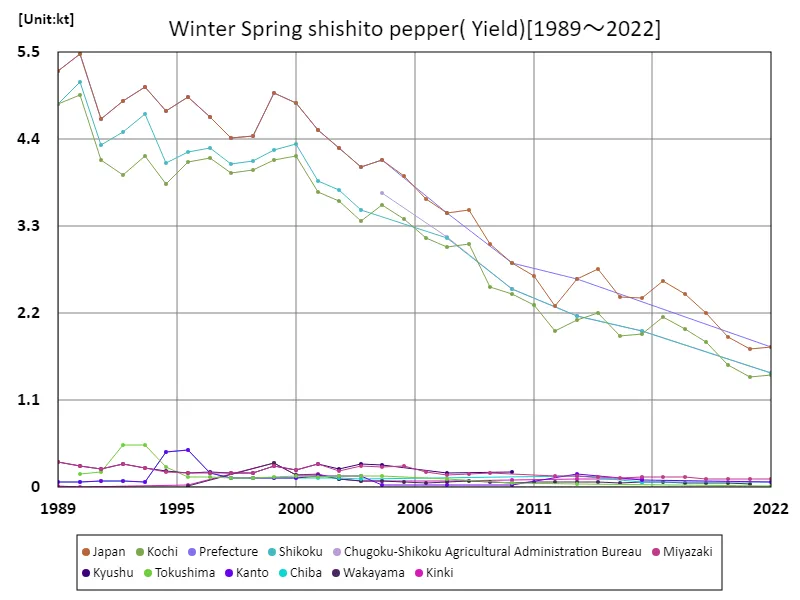

The maximum is 5.48kt[1990] of Japan, and the current value is about 32.5%
Harvest volume of shishito peppers, one of the winter/spring peppers (by prefecture).
The latest data on fruit and vegetable harvests in Japan is for 2022, and prefecture-by-prefecture data shows that Kochi recorded the highest overall yield of 1.42kt, the highest figure to date. Judging from these figures, Kochi Prefecture may have an advantage in fruit and vegetable production. Factors contributing to this include climatic conditions, developments in agricultural technology, and improvements in production systems. On the other hand, harvest volumes in other prefectures tend to be lower than in Kochi, but certain fruit and vegetable crops may be produced more abundantly in certain areas. Additionally, changes in demand for fruit vegetables and improvements in transportation and distribution may also be affecting harvest yields. In the future, effective production strategies and support measures will be needed depending on the characteristics and challenges of each region, including Kochi Prefecture.
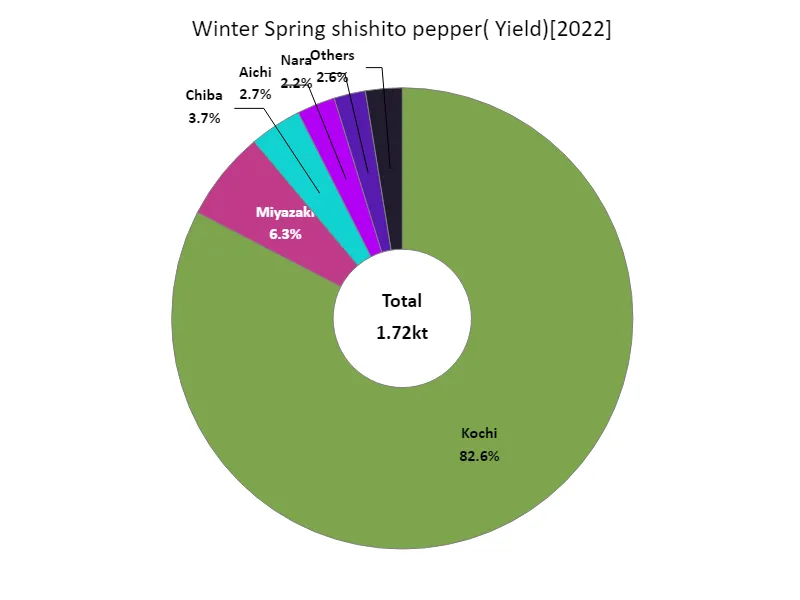

The maximum is 1.42kt of Kochi, the average is 123t, and the total is 1.72kt
Planted area of shishito peppers among winter and spring peppers (main data).
Looking at data on the area of shishito pepper cultivation in Japan from 1989 to 2022, the area reached a record peak of 90 hectares nationwide in 1990. However, looking at the subsequent trends, the area under cultivation has now fallen to 33.3% of its peak. Possible reasons for this decline include increased productivity through agricultural modernization and technological innovation, and changes in land use. Urbanization of farmland and a decline in the agricultural labor force may also be contributing factors. On the other hand, shishito cultivation varies by region, and the area devoted to it may remain relatively constant in particularly productive regions. In the future, efforts will be required to stabilize and expand the area of shishito pepper cultivation, taking into account changes in demand and the effects of climatic conditions.
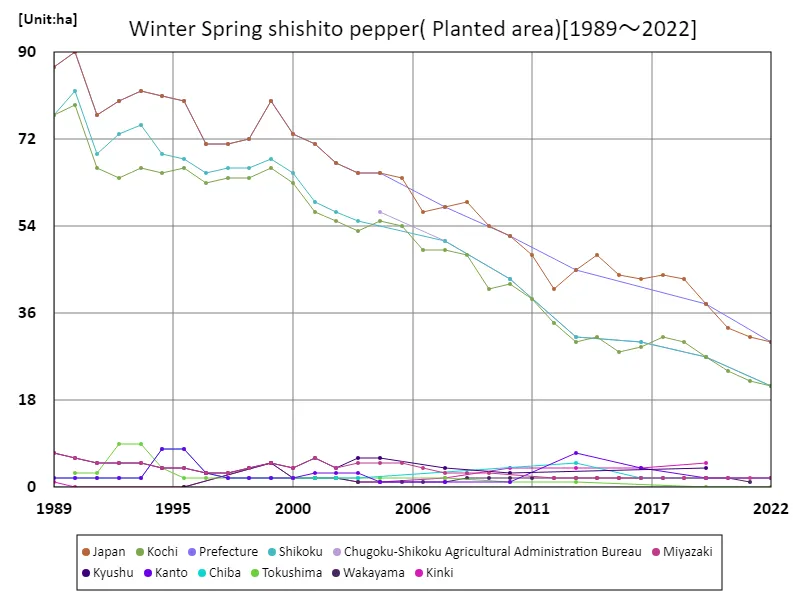

The maximum is 90ha[1990] of Japan, and the current value is about 33.3%
The area planted with shishito peppers, a winter/spring pepper variety, by prefecture.
The latest data on the area of land planted with fruit vegetables in Japan is for 2022, and data by prefecture shows that Kochi recorded the highest area overall at 21ha, the highest value to date. Based on these figures, Kochi Prefecture may have an advantage in cultivating fruit vegetables. These factors include climatic conditions, suitability of land use, advances in agricultural technology, or supportive agricultural policies. On the other hand, the area of land cultivated with fruit vegetables in other prefectures tends to be lower than in Kochi, but it is possible that in some areas, cultivation is specialized in certain fruit vegetables. Fluctuations in acreage should also take into account changes in demand and the impact of market prices. In the future, effective agricultural policies and support measures tailored to the characteristics and challenges of each region will be needed. In particular, in order to expand cultivated land area, it will be important to develop sustainable agricultural systems and promote technological innovation.
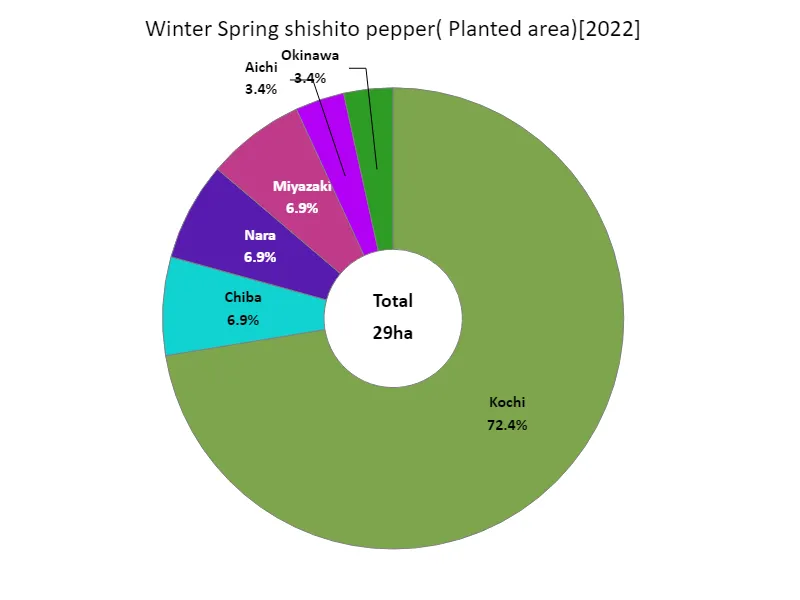

The maximum is 21ha of Kochi, the average is 4.83ha, and the total is 29ha
Shipment volume of Shishito peppers among winter and spring peppers.
According to data from 2022, Kochi has the highest overall shipment volume of Shishito peppers in Japan at 1.35kt, with an average shipment volume of 135t and a total shipment volume of 1.61kt. Judging from these figures, it appears that shishito pepper production has relatively pronounced regional characteristics, with Kochi Prefecture being a particularly prominent region for shishito pepper production. Also, since the average shipping volume was 135 tons, it is possible that individual producers are shipping relatively small amounts of shishito peppers. This suggests that shishito pepper cultivation is carried out by smallholder farmers. Furthermore, the overall shipment volume of 1.61kt indicates that demand for shishito peppers is relatively stable. Shishito peppers are generally deeply rooted in Japanese food culture and tend to be in high demand, so producers may be producing them to meet constant demand. Given these trends, it can be said that although shishito pepper production varies from region to region, it is carried out efficiently with demand in mind. In the future, it will be necessary to ensure sustainable production and supply of shishito peppers while responding flexibly to changes in demand and the effects of climatic conditions.
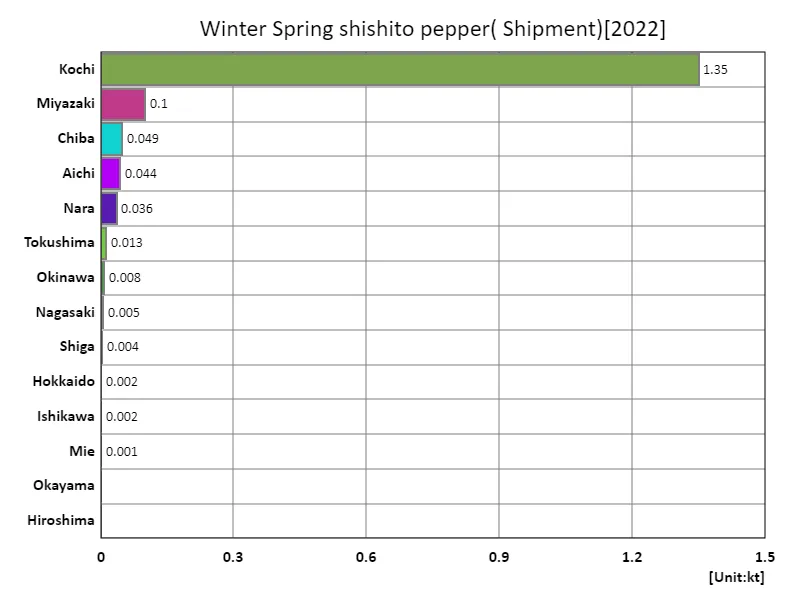

The maximum is 1.35kt of Kochi, the average is 135t, and the total is 1.61kt
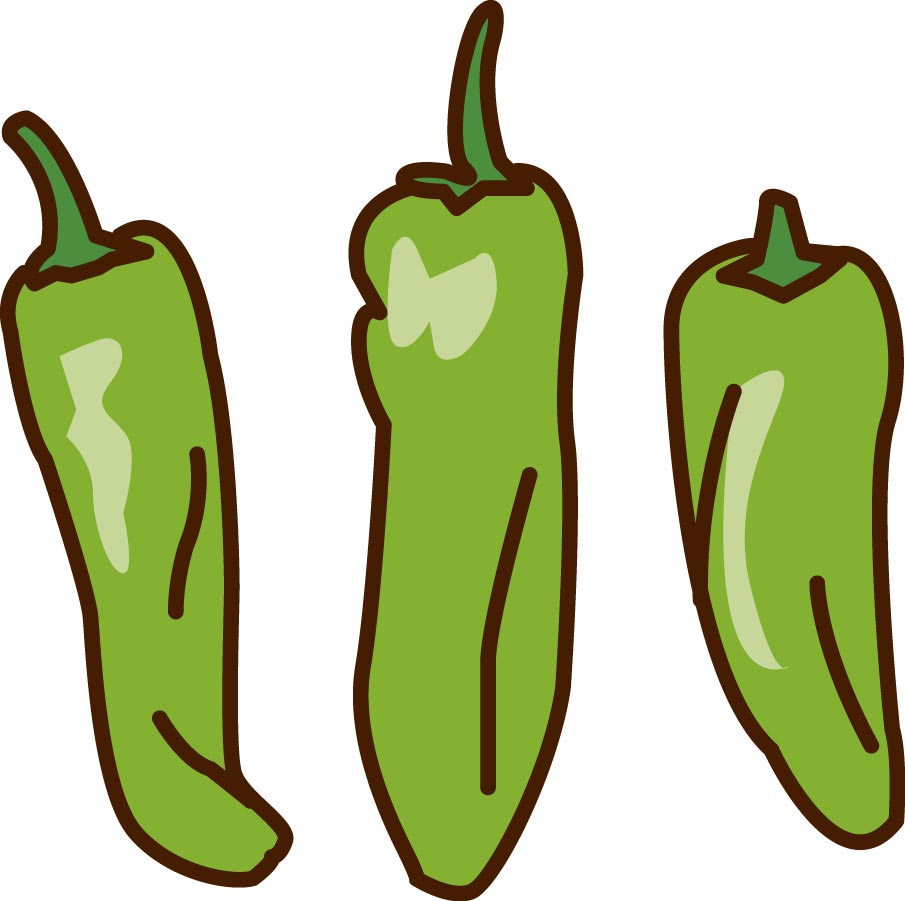


Comments